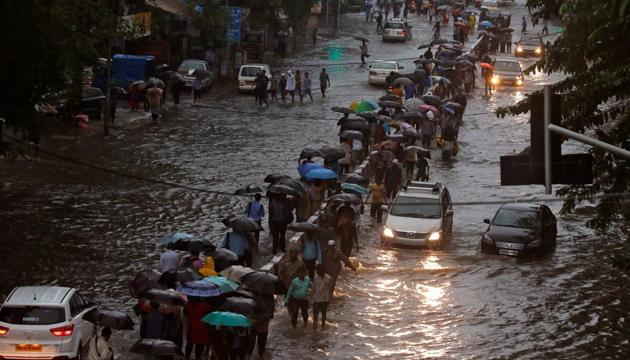Mumbai rains: Govt, civic officials had enough time to prepare but failed miserably
Mumbai recorded 315.8mm in the 12 hours from 8.30am on Tuesday, less than half of the 644 mm that fell in 12 hours during the deluge of July 26, 2005, which saw a total of 944 mm rainfall. But the effect was devastating.
Heavy rain pounded the city between 8.30am and 1.30pm, virtually paralysing transportation systems and inundating roads. However, Brihanmumbai Municipal Corporation’s (BMC) released its first proper advisory, asking people to stay indoors, only around 2pm. By then, the city’s drains, capable of handling only 25mm of rain an hour, had already gone under.

The Maharashtra government, too, sprung into action much after mid-day. After wrapping up a cabinet meeting at noon, chief minister Devendra Fadnavis took stock of the situation and visited disaster management control centres in the afternoon. For the first part of the day, officials associated with the state disaster management cell maintained the situation is not dire and that the state was keeping a close watch. It also said that the first respondents to disaster, be it the BMC or the police, were tackling the problem.
Mumbai is no stranger to torrential rain, which has, on a number of occasions, strained weak infrastructure and battered the city, leaving people stranded. However, preventive disaster management and advisories remain a tall order for the city’s authorities.
The Colaba observatory of the Indian Meteorological Department (IMD) on Monday issued a statement to warn about heavy rain in the next 24 hours, after which the BMC sent out a perfunctory advisory through a press statement conveying the message. Despite that state authorities seemed to have taken things lightly. No efforts were made to ensure smooth commute as lakhs of people remained stranded at various stations waiting for suburban trains to go home.
Even the state government’s circular to its own employees allowing them to leave work at 2.30pm was issued an hour later, after 3.30pm.
Medha Gadgil, additional chief secretary, relief and rehabilitation, however, said authorities informed all secretaries in advance verbally to let employees leave early and it was just the written word that was delayed. “For preventive disaster management, our control room is operational 24/7. Moreover, the first respondents send out advisories based on weather warnings,” she said.
Besides IMD warnings, the BMC also has its own 60 automatic rain gauges at 58 locations to rely on. Of these, 54 transmit rainfall data to the BMC’s disaster control room every 15 minutes. They are also equipped with a console that can give an audible alarm if rainfall intensity exceeds 10mm in 15 minutes.
Sudhir Naik, deputy municipal commissioner of general administration in the BMC, said, the civic body takes preventive measures such as installing localised pumps to prevent water logging, activate its six pumping stations across the city and use sewerage pumping machinery to drain water into the sea. “When we have warnings like the one today, our staff is sent to the field in the morning. We deliberately sent out the first advisory late on Tuesday as trains stopped functioning around 12.30-1pm. If we had raised an advisory before that, people would have tried to step out and get home, and in turn get stranded on roads,” he said.
City-based environmental activist Rishi Agarwal said, “More forceful advisories, like the ones sent out on Tuesday, could have been issued on Monday itself, knowing the situation and the weather warning. But people also need to start taking these advisories seriously when we know the administration is failing us.”
IC Sisodia, former chief officer of the BMC’s special vigilance cell and disaster management cell, said there is negligible preventive management and preparation for disasters. “The disaster management cell functions literally like a call centre. People who man the phones are not very well educated or appropriately trained to tackle warnings or respond to calls. The flood preparation manuals never reach the mobilised field staff,” said Sisodia, who retired in 1995. He wrote a letter to Fadnavis pointing out the lacunae in disaster management in June, but did not receive a reply.
He also highlighted the futility of the Greater Metropolitan Disaster Management Authority, a panel comprising the municipal commissioner, chief of the MMRDA, home guard and other members, and general managers of the Central and Western Railway. “The authority is supposed to meet every three months, but that has not really helped as it should have to prevent days like today,” he added
Stay updated with all the Breaking News and Latest News from Mumbai. Click here for comprehensive coverage of top Cities including Bengaluru, Delhi, Hyderabad, and more across India along with Stay informed on the latest happenings in World News.
Stay updated with all the Breaking News and Latest News from Mumbai. Click here for comprehensive coverage of top Cities including Bengaluru, Delhi, Hyderabad, and more across India along with Stay informed on the latest happenings in World News.





